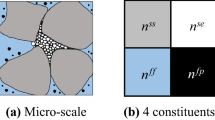Abstract
The hydraulic erosion of a fine particle fraction (-fines-) from a granular layer is investigated analytically and computationally. The erosion is assumed to occur instantaneously leading to an internal boundary value problem. A low-porosity domain is separated from a high-porosity domain by a propagating, spatial discontinuity surface. The level set method is applied to computationally simulate the propagation of the discontinuity surface or interface over time. Examples for such interfaces are ubiquitous in geomechanics and include reaction fronts, free surfaces in Eulerian formulations, and infiltration and injection fronts. First, a linear instability analysis is conducted and the resulting dispersion relationship is discussed. The analysis indicates that the interface problem is ill-posed. A stabilization term proportional to the curvature of the interface is introduced into the Stefan condition restoring well posedness. Subsequently, a finite element-based level set technique is applied to computationally investigate the propagation and stability of the discontinuity surface. The mesh independence of the solution upon introduction of the regularizing curvature term is also demonstrated. Techniques are presented for the treatment of the hyperbolic differential system at the core of the interface dynamics. These techniques are based upon an algorithm developed in the finite difference context, but are modified to take advantage of the robustness and flexibility of the finite element method.






Similar content being viewed by others
References
Davies M, Muhlhaus H, Gross L (2006) Thermal effects in the evolution of initially layered mantle material. Pure Appl Geophys 163(11–12):2485–2495
Den Adel H, Bakker KJ (1993) A transport model for filtration: control of erosion processes. In: Brauns J et al (eds) Filters in Geotechnical and Hydraulic Engineering, Balkema, Rotterdam, pp 189–196
Fasano A, Primicerio M (1979) Free boundary problems for nonlinear parabolic equations with nonlinear free boundary conditions. J Math Anal Appl 72:247–273
Fell R, Fry J–J (2007) Internal erosion of dams and their foundations. Taylor & Francis, London
Gross, L. (eds) (2012): esys-Escript users guide, The University of Queensland
Gross L, Bourgouin L, Hale AJ, Muhlhaus HB (2007) Interface modeling in incompressible media using level sets in escript. Phys Earth Planet Inter 163:23–34
Gross L, Poulet T, Sheldon HA (2013) Conforming finite-element methods for modeling convection in an incompressible rock matrix transport in porous media, 100:2 225–246, http://link.springer.com/journal/11242/100/2/page/1, doi:10.1007/s11242-013-0213-3
Muhlhaus H, Gross L (2013) Interface modeling based on level sets, Euro: Tun 2013, 3rd Int. Conf. Comp. Meth. Tunneling Subsurface Eng. Ruhr University Bochum, 17–19 April
Orteleva P, Chadam J, Merino E, Sen A (1987) Geochemical self organization II: the reactive infiltration instability. Am J Sci 287:1008–1040
Scheuermann A, Vardoulakis I, Papanastasiou P, Stavropoulou M (1999) A sand erosion problem in axial flow conditions on the example of contact erosion due to horizontal groundwater flow. IUTAM, Kluwer Academic Publishers, Dordrecht, pp 169–175
Steeb H, Diebels S, Vardoulakis I (2007) Modeling phase transition processes within porous media. In Siegel TC et al. (eds.) Proc. Geo-Denver 2007, February 18–21, 2007, Denver, Colorado, US, ASCE Geotechnical Special Publication, No 157
Sussman M, Smereka P, Osher S (1994) A level set approach for computing solutions to incompressible two-phase flow. J Comput Phys 114:146–159
Tornberg A-K, Engquist B (2000) A finite element based level-set method for multiphase flow applications. Comput Visual Sci 3:93–101
Vardoulakis I (2004) Fluidisation in artesian flow conditions: hydromechanically unstable granular media. Geotechnique 54:165–177
Zhenfu L, Qingru C (2001) Dry beneficiation technology of coal with an air dense-medium fluidized bed. Int J Miner Process 63:167–175
Zienkiewicz OC, Taylor RL, Zhu JZ (2005) The finite element method: its basis and fundamentals, 6th edn. Elsevier, Oxford
Acknowledgments
The support by the Australian research council (ARC) through the discovery grants DP120102188: Hydraulic erosion of granular structures is gratefully acknowledged and DP140100490: Qualitative and quantitative modelling of hydraulic fracturing of brittle materials. The second author would like to acknowledge the support by the AuScope National Collaborative Research Infrastructure Strategy and the Australian Geophysical Observatory System (AGOS).
Author information
Authors and Affiliations
Corresponding author
Rights and permissions
About this article
Cite this article
Muhlhaus, H., Gross, L. & Scheuermann, A. Sand erosion as an internal boundary value problem. Acta Geotech. 10, 333–342 (2015). https://doi.org/10.1007/s11440-014-0322-3
Received:
Accepted:
Published:
Issue Date:
DOI: https://doi.org/10.1007/s11440-014-0322-3




